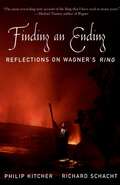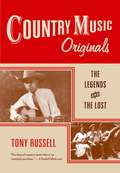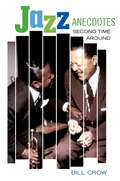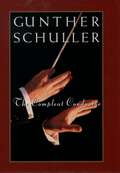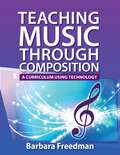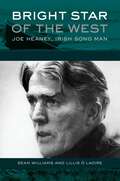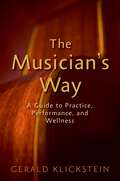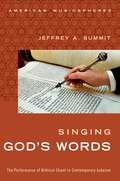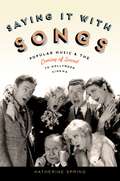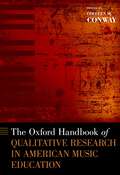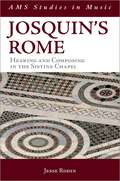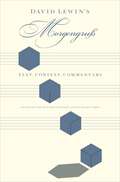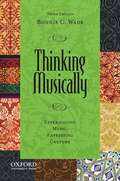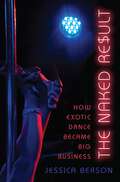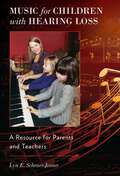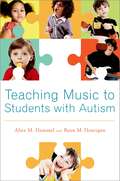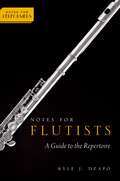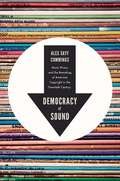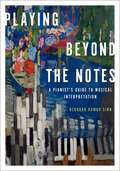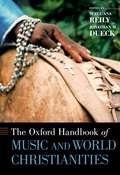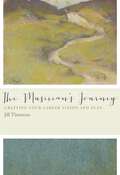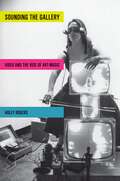- Table View
- List View
Finding an Ending: Reflections on Wagner's Ring
by Philip Kitcher Richard SchachtFew musical works loom as large in Western culture as Richard Wagner's four-part Ring of the Nibelung. In Finding an Ending, two eminent philosophers, Philip Kitcher and Richard Schacht, offer an illuminating look at this greatest of Wagner's achievements, focusing on its far-reaching and subtle exploration of problems of meanings and endings in this life and world. Kitcher and Schacht plunge the reader into the heart of Wagner's Ring, drawing out the philosophical and human significance of the text and the music. They show how different forms of love, freedom, heroism, authority, and judgment are explored and tested as it unfolds. As they journey across its sweeping musical-dramatic landscape, Kitcher and Schacht lead us to the central concern of the Ring--the problem of endowing life with genuine significance that can be enhanced rather than negated by its ending, if the right sort of ending can be found. The drama originates in Wotan's quest for a transformation of the primordial state of things into a world in which life can be lived more meaningfully. The authors trace the evolution of Wotan's efforts, the intricate problems he confronts, and his failures and defeats. But while the problem Wotan poses for himself proves to be insoluble as he conceives of it, they suggest that his very efforts and failures set the stage for the transformation of his problem, and for the only sort of resolution of it that may be humanly possible--to which it is not Siegfried but rather Brünnhilde who shows the way. The Ring's ending, with its passing of the gods above and destruction of the world below, might seem to be devastating; but Kitcher and Schacht see a kind of meaning in and through the ending revealed to us that is profoundly affirmative, and that has perhaps never been so powerfully and so beautifully expressed.
Country Music Originals: The Legends and the Lost
by Tony RussellGraced by more than 200 illustrations, many of them seldom seen and some never before published, this sparkling volume offers vivid portraits of the men and women who created country music, the artists whose lives and songs formed the rich tradition from which so many others have drawn inspiration. Included here are not only such major figures as Jimmie Rodgers, The Carter Family, Fiddlin' John Carson, Charlie Poole, and Gene Autry, who put country music on America's cultural map, but many fascinating lesser-known figures as well, such as Carson Robison, Otto Gray, Chris Bouchillon, Emry Arthur and dozens more, many of whose stories are told here for the first time. To map some of the winding, untraveled roads that connect today's music to its ancestors, Tony Russell draws upon new research and rare source material, such as contemporary newspaper reports and magazine articles, internet genealogy sites, and his own interviews with the musicians or their families. The result is a lively mix of colorful tales and anecdotes, priceless contemporary accounts of performances, illuminating social and historical context, and well-grounded critical judgment. The illustrations include artist photographs, record labels, song sheets, newspaper clippings, cartoons, and magazine covers, recreating the look and feel of the entire culture of country music. Each essay includes as well a playlist of recommended and currently available recordings for each artist. Finally, the paperback edition now features an extensive index.
Jazz Anecdotes: Second Time Around
by Bill CrowWhen jazz musicians get together, they often delight one another with stories about the great, or merely remarkable, players and singers they've worked with. One good story leads to another until someone says, "Somebody ought to wrie these down!" With Jazz Anecdotes, somebody finally has. Drawing on a rich verbal tradition, bassist and jazz writer Bill Crow has culled stories from a wide variety of sources, including interviews, biographies and a remarkable oral history collection, which resides at the Institute of Jazz Studies at Rutgers University, to paint fascinating and very human portraits of jazz musicians. Organized around general topics--teaching and learning, life on the road, prejudice and discrimination, and the importance of a good nickname--Jazz Anecdotes shows the jazz world as it really is. In this fully updated edition, which contains over 150 new anecdotes and new topics like Hiring and Firing, Crow regales us with new stories of such jazz greats as Benny Goodman, Chet Baker, Ravi Coltrane, Buddy Rich and Paul Desmond. He offers extended sections on old favorites--Louis Armstrong, Duke Ellington, Coleman Hawkins and Lester Young, and the fabulous Eddie Condon, who seems to have lived his entire life with the anecdotist in mind. With its unique blend of sparkling dialogue and historical and social insight, Jazz Anecdotes will delight anyone who loves a good story. It offers a fresh perspective on the joys and hardships of a musician's life as well as a rare glimpse of the personalities who created America's most distinctive music.
The Compleat Conductor
by Gunther SchullerA world-renowned conductor and composer who has lead most of the major orchestras in North America and Europe, a talented musician who has played under the batons of such luminaries as Toscanini and Walter, and an esteemed arranger, scholar, author, and educator, Gunther Schuller is without doubt a major figure in the music world. Now, in The Compleat Conductor, Schuller has penned a highly provocative critique of modern conducting, one that is certain to stir controversy. Indeed, in these pages he castigates many of this century's most venerated conductors for using the podium to indulge their own interpretive idiosyncrasies rather than devote themselves to reproducing the composer's stated and often painstakingly detailed intentions. Contrary to the average concert-goer's notion (all too often shared by the musicians as well) that conducting is an easily learned skill, Schuller argues here that conducting is "the most demanding, musically all embracing, and complex" task in the field of music performance. Conducting demands profound musical sense, agonizing hours of study, and unbending integrity. Most important, a conductor's overriding concern must be to present a composer's work faithfully and accurately, scrupulously following the score including especially dynamics and tempo markings with utmost respect and care. Alas, Schuller finds, rare is the conductor who faithfully adheres to a composer's wishes. To document this, Schuller painstakingly compares hundreds of performances and recordings with the original scores of eight major compositions: Beethoven's fifth and seventh symphonies, Schumann's second (last movement only), Brahms's first and fourth, Tchaikovsky's sixth, Strauss's "Till Eulenspiegel" and Ravel's "Daphnis et Chloe, Second Suite." Illustrating his points with numerous musical examples, Schuller reveals exactly where conductors have done well and where they have mangled the composer's work. As he does so, he also illuminates the interpretive styles of many of our most celebrated conductors, offering pithy observations that range from blistering criticism of Leonard Bernstein ("one of the world's most histrionic and exhibitionist conductors") to effusive praise of Carlos Kleiber (who "is so unique, so remarkable, so outstanding that one can only describe him as a phenomenon"). Along the way, he debunks many of the music world's most enduring myths (such as the notion that most of Beethoven's metronome markings were "wrong" or "unplayable," or that Schumann was a poor orchestrator) and takes on the "cultish clan" of period instrument performers, observing that many of their claims are "totally spurious and chimeric." In his epilogue, Schuller sets forth clear guidelines for conductors that he believes will help steer them away from self indulgence towards the correct realization of great art. Courageous, eloquent, and brilliantly insightful, The Compleat Conductor throws down the gauntlet to conductors worldwide. It is a controversial book that the music world will be debating for many years to come.
Teaching Music Through Composition: A Curriculum Using Technology
by Barbara FreedmanTeaching Music through Composition offers a practical, fully multimedia curriculum designed to teach basic musical concepts through the creative process of music composition. Author and award-winning music educator Barbara Freedman presents classroom-tested ways of teaching composition with technology as a tool with which students can create, edit, save, and reproduce music. As Freedman demonstrates, technology allows a musical experience for all skill levels in opportunities never before available to compose manipulate, instantly listen to music electronically and even print standard Western music notation for others to play without having to know much about traditional music theory or notation. All students can have meaningful hands-on applied learning experiences that will impact not only their music experience and learning but also their understanding and comfort with 21st century technology. Whether the primary focus of your class is to use technology to create music or to explore using technology in a unit or two, this book will show you how it can be done with practical, tried-and-true lesson plans and student activities.
Bright Star of the West: Joe Heaney, Irish Song Man (American Musicspheres)
by Sean Williams Lillis Ó LaoireBright Star of the West examines the life, repertoire, and influence of Ireland's greatest sean-nos (old-style) singer, Joe Heaney (1919-1984). Best known for popularing this form of Gaelic a cappella folk song in the United States, authors Sean Williams and Lillis Ó Laoire reveal the ways in which Heaney's life story demonstrates the intertwining of music with political memory and cultural understanding.
The Musician's Way: A Guide to Practice, Performance, and Wellness
by Gerald KlicksteinIn The Musician's Way, veteran performer and educator Gerald Klickstein combines the latest research with his 30 years of professional experience to provide aspiring musicians with a roadmap to artistic excellence. Part I, Artful Practice, describes strategies to interpret and memorize compositions, fuel motivation, collaborate, and more. Part II, Fearless Performance, lifts the lid on the hidden causes of nervousness and shows how musicians can become confident performers. Part III, Lifelong Creativity, surveys tactics to prevent music-related injuries and equips musicians to tap their own innate creativity. Written in a conversational style, The Musician's Way presents an inclusive system for all instrumentalists and vocalists to advance their musical abilities and succeed as performing artists.
Bright Star of the West: Joe Heaney, Irish Song Man (American Musicspheres)
by Sean Williams Lillis Ó LaoireBright Star of the West examines the life, repertoire, and influence of Ireland's greatest sean-nos (old-style) singer, Joe Heaney (1919-1984). Best known for popularing this form of Gaelic a cappella folk song in the United States, authors Sean Williams and Lillis Ó Laoire reveal the ways in which Heaney's life story demonstrates the intertwining of music with political memory and cultural understanding.
SINGING GOD WORDS IN GOD OWN TUNE AM C: The Performance of Biblical Chant in Contemporary Judaism (American Musicspheres)
by Jeffrey SummitSinging God's Words is the first in-depth study of the experience and meaning of chanting or "reading" Torah among contemporary American Jews. This experience has been transformed dramatically in recent years by the impact of digital technology, feminism, the empowerment of lay people and a search for self-fulfillment through involvement with community. At a time when worshippers seek deeper spiritual experience, many Jews have found new meaning in the experience of reading Torah, an act that is broadly accessible to Jewish adults even as it requires intensive immersion with the text of the Bible in Hebrew. This book examines why and how growing numbers of American Jews in all denominations see the public chanting of Biblical texts during the synagogue service as one of the most authentic and personal expressions of their religious identity. Drawing on hundreds of interviews with men and women, both professionals and congregants, Jeffrey A. Summit describes how the reading of Torah embodies their understanding of historical religious practice, even as it is shaped by contemporary views of spiritual experience. Through this act, holiness becomes manifest at the intersection of Biblical chant, sacred text, the individual, and the community.
Saying It With Songs: Popular Music and the Coming of Sound to Hollywood Cinema (Oxford Music / Media)
by Katherine SpringHollywood's conversion from silent to synchronized sound film production not only instigated the convergence of the film and music industries but also gave rise to an extraordinary period of songs in American cinema. Saying It With Songs considers how the increasing interdependence of Hollywood studios and Tin Pan Alley music publishing firms influenced the commercial and narrative functions of popular songs. While most scholarship on film music of the period focuses on adaptations of Broadway musicals, this book examines the functions of songs in a variety of non-musical genres, including melodramas, romantic comedies, Westerns, prison dramas, and action-adventure films, and shows how filmmakers tested and refined their approach to songs in order to reconcile the spectacle of song performance, the classical norms of storytelling, and the conventions of background orchestral scoring from the period of silent cinema. Written for film and music scholars alike as well as for general readers, Saying It With Songs illuminates the origins of the popular song score aesthetic of American cinema.
The Oxford Handbook of Qualitative Research in American Music Education (Oxford Handbooks)
by Colleen M. ConwayQualitative research has become increasingly popular in music education over the last decade, yet there is no source that explains the terms, approaches and issues associated with this approach. In The Oxford Handbook of Qualitative Research in American Music Education, editor Colleen Conway and the contributing music educators provide that clarification, as well as models of qualitative studies within various music education disciplines. The handbook outlines the history of qualitative research in American music education and explores the contemporary use of qualitative approaches in examining issues related to music teaching and learning. It includes 32 chapters that address a range of topics, from ways of approaching qualitative research and ways of collecting and analyzing data, to the various music teaching and learning contexts that have been studied using qualitative approaches. The final section of the book tackles permission to conduct research, teaching qualitative research, publishing qualitative research, and provides direction for the future. An ambitious and much-needed volume, this handbook will stand as a key resource for drawing meaning from the experiences of students and teachers in music classrooms and communities both in America and in other countries.
Josquin's Rome: Hearing and Composing in the Sistine Chapel (AMS Studies in Music)
by Jesse RodinIn the late fifteenth century the newly built Sistine Chapel was home to a vigorous culture of musical composition and performance. Josquin des Prez stood at its center, singing and composing for the pope's private choir. Josquin's Rome offers a new reading of the composer's work in light of the repertory he and his fellow papal singers performed from the chapel's singers' box. Comprising the single largest surviving corpus of late fifteenth-century sacred music, these pieces served as a backdrop for elaborately choreographed liturgical ceremonies--a sonic analogue to the frescoes by Botticelli, Perugino, and their contemporaries that adorn the chapel's walls. Jesse Rodin uses a comparative approach to uncover this aesthetically and intellectually rich musical tradition. He confronts longstanding problems concerning the authenticity and chronology of Josquin's music while offering nuanced readings of scandalously understudied works by the composer's contemporaries. The book further contextualizes Josquin by locating intersections between his music and the wider soundscape of the Cappella Sistina. Central to Rodin's argument is the idea that these pieces lived in performance. The author puts his interpretations into practice through a series of exquisite recordings by his ensemble, Cut Circle (available both on the companion website and as a CD from Musique en Wallonie). Josquin's Rome is an essential resource for musicologists, scholars of the Italian Renaissance, and enthusiasts of early music.
David Lewin's Morgengruß: Text, Context, Commentary
by David Bard-Schwarz Richard CohnArguably one of the most influential and revered figures in contemporary music theory, David Lewin (1933-2003) revolutionized the field through his work on transformational theory and theoretical methodology. David Lewin's Morgengruß: Text, Context, Commentary presents in print for the first time Lewin's legendary 1974 essay on Franz Schubert's "Morgengruß," from the composer's song cycle, Die Schöne Müllerin. The essay was central to Lewin's graduate teaching, and copies of it have circulated by hand through the music-scholarly community for decades. This book presents the original text of Lewin's essay along with over 200 graphical illustrations. Lewin's ability to present an artful and rich argument, based on a close reading of a short, "simple" score is but one of the wonders to behold in his masterful essay. At once deeply nuanced and widely accessible, Lewin's "Morgengruß" offers insight into Schubert's composition as well as the analytical process itself. Along with the full text of Lewin's essay, this book includes a small but pointed collection of essays interpreting the content and significance of Lewin's "Morgengruß." Drawing on current research as well as personal reflection, editors Richard Cohn and David Bard-Schwarz, along with contributors Brian Kane and Henry Klumpenhouwer, elaborate on the analytical, pedagogical, and philosophical contexts of Lewin's work. Taken together, the editors and contributors offer a compelling account of the enduring significance of Lewin's writing. David Lewin's Morgengruß is a must-have for anyone with an interest in Lewin's career, Schubert's music, or music theory generally.
Thinking Musically: Experiencing Music, Expressing Culture (pdf) (Global Music Ser.)
by Bonnie C. WadeAs the cornerstone of the Global Music Series, Thinking Musically, Third Edition, explores musical diversity by integrating the sounds and traditions of world cultures. Bonnie C. Wade discusses how various cultural influences-gender, ethnicity, mass media, westernization, nationalism, and acculturation-are shaping music and the ways that we experience it. WHAT'S NEW TO THE THIRD EDITION? * Simplified and incorporates recent additions to the Global Music Series * New charts and diagrams delve into important musical concepts * Updated companion website includes a new guide to online and print resources, a sample syllabi, and teaching tips Visit www.oup.com/us/globalmusic for a list of case studies in the Global Music Series. The website also includes instructional material to accompany each study.
Singing God's Words: The Performance of Biblical Chant in Contemporary Judaism (American Musicspheres)
by Jeffrey SummitSinging God's Words is the first in-depth study of the experience and meaning of chanting or "reading" Torah among contemporary American Jews. This experience has been transformed dramatically in recent years by the impact of digital technology, feminism, the empowerment of lay people and a search for self-fulfillment through involvement with community. At a time when worshippers seek deeper spiritual experience, many Jews have found new meaning in the experience of reading Torah, an act that is broadly accessible to Jewish adults even as it requires intensive immersion with the text of the Bible in Hebrew. This book examines why and how growing numbers of American Jews in all denominations see the public chanting of Biblical texts during the synagogue service as one of the most authentic and personal expressions of their religious identity. Drawing on hundreds of interviews with men and women, both professionals and congregants, Jeffrey A. Summit describes how the reading of Torah embodies their understanding of historical religious practice, even as it is shaped by contemporary views of spiritual experience. Through this act, holiness becomes manifest at the intersection of Biblical chant, sacred text, the individual, and the community.
The Naked Result: How Exotic Dance Became Big Business
by Jessica BersonWe have grown accustomed to corporate influence in retail outlets, restaurants, and even higher education-but what happens when corporations take over desire? The Naked Result: How Exotic Dance Became Big Business explores the changing world of striptease, tracing its path from the unruly underground to brightly lit, branded 'gentlemen's clubs.' Drawing on her own experience as an exotic dancer, Jessica Berson examines the ways that striptease embodies conflicting notions of race, class, and female sexuality, and how the exotic dance industry deploys these differences to codify and commodify our erotic imagination. Chain clubs, fitness programs, and music videos are moving exotic dance into the mainstream, stripping its historical potential to embody and express subversive desires-erotic and otherwise-and generate resistant modes of female erotic subjectivity. Through case studies including Boston's Combat Zone in the 1970s-80s, the development of lap dancing in London in the 1990s, and the triumph of corporate striptease in post-Giuliani New York City in the last decade,The Naked Result reveals an industry that increasingly eradicates individuality and agency in order to increase profits. Ultimately, The Naked Result argues that corporatization has cheerfully smothered the diversity of desire and expression for both dancers and customers, repackaging the most mysterious human emotions into easily branded experiences no more personal or powerful than those to be found in any themed restaurant or coffee mega-chain.
Music for Children with Hearing Loss: A Resource for Parents and Teachers
by Lyn Schraer-JoinerWritten by an expert in the field who is both a teacher and a teacher-educator, this book is an in-depth and practical resource for educators and parents who wish to introduce music to children with hearing loss. Author Lyn Schraer-Joiner makes a compelling case for offering music education to children with hearing loss before presenting a series of important and up-to-date teaching strategies meant to inform their educational experience, including preparations for the classroom, communication strategies for parents and teaching staff, and tips on more specific or technical matters such as conducting musical audiograms. These resources provide a solid background for hands-on instructional materials such as music lessons, supplemental activities, educational resources, discussion points, and journal samples for the classroom and home. Schraer-Joiner goes to great lengths to offer detailed, purposeful suggestions for specific classroom settings such as general music, choral ensemble, and instrumental ensemble as well as a set of recommended listening lessons that take this potential variety of settings into account. Furthermore, Schraer-Joiner provides suggestions for incorporating music into everyday activities and also presents an overview of recent research which reinforces the benefits of music upon social and emotional development as well as speech and language development. Each chapter concludes with a section entitled "For Your Consideration" which features review questions, ideas, and instructional activities that teachers and parents can accomplish with deaf and hard of hearing children. The book's "Kids Only" online component provides deaf and hard-of-hearing children with descriptions of the many opportunities available to them in the arts, inspirational case studies and stories, as well as important ideas and topics for deaf and hard-of-hearing children to consider discussing with the teachers, family members, and healthcare professionals that they work with. The message of this book is a powerful one particularly in this day and age. As hearing aid and cochlear implant technologies improve and become increasingly widespread, all teachers--especially music teachers--should expect to see more deaf and hard-of-hearing children in their classrooms. Awareness and preparation are not only vital in aiding these children in the classroom, but are in fact required of teachers by federal law. This book is a comprehensive resource for teachers and parents who wish to gain a better understanding of the emerging field of music education for students with hearing loss.
Teaching Music to Students with Autism
by Alice M. Hammel Ryan M. HouriganTeaching Music to Students with Autism is a comprehensive resource for everyone who works with students with autism within the music classroom. The authors focus on understanding autism, advocating for students and music programs, and creating and maintaining a team approach by working together with colleagues effectively. A significant portion of the book is focused on understanding and overcoming the communication, cognition, behavior, sensory, and socialization challenges inherent in working with students with autism. The authors suggest ways to structure classroom experiences and learning opportunities for all students. The book includes vignettes and classroom snapshots from experienced music teachers which provide additional opportunities to transfer theory to real-life application.
Notes for Flutists: A Guide to the Repertoire (Notes for Performers)
by Dr. Kyle DzapoNotes for Flutists: A Guide to the Repertoire offers important historical and analytical information about three dozen of the best-known pieces written for the instrument. Its contextual and theoretical insights make it an essential resource for professional, amateur, and student flutists. With engaging prose supported by fact-filled analytical charts, the book offers rich biographical information and informative analyses to help flutists gain a more complete understanding of J. S. Bach's Sonata in B minor, Reinecke's Undine Sonata, Fauré's Fantaisie, Hindemith's Sonata for Flute and Piano, Copland's Duo for Flute and Piano, and 30 other masterpieces. Offering a faithful and comprehensive guide to understanding the contexts in which the repertoire was composed, Notes for Flutists details in clear, chronological order flute repertoire from Telemann, Mozart, and Enescu to Prokofiev, Poulenc, and Muczynski. Kyle Dzapo includes biographical information on each composer and highlights history's impact on the creation and performance of important works for flute. Intended as a starting point for connecting performance studies with scholarship, Dr. Dzapo's analysis will help flutists gain a more complete picture of a given work. Its valuable insights make it essential to musicians preparing and presenting programs, and its detailed historical information about the work and composer will encourage readers to explore other works in a similarly analytical way. Covering concertos, chamber pieces, and works for solo flute, Kyle Dzapo presents Notes for Flutists, an indispensable handbook for students and professionals alike.
Democracy of Sound: Music Piracy and the Remaking of American Copyright in the Twentieth Century
by Alex Sayf CummingsIt was a time when music fans copied and traded recordings without permission. An outraged music industry pushed Congress to pass anti-piracy legislation. Yes, that time is now; it was also the era of Napster in the 1990s, of cassette tapes in the 1970s, of reel-to-reel tapes in the 1950s, even the phonograph epoch of the 1930s. Piracy, it turns out, is as old as recorded music itself. In Democracy of Sound, Alex Sayf Cummings uncovers the little-known history of music piracy and its sweeping effects on the definition of copyright in the United States. When copyright emerged, only visual material such as books and maps were thought to deserve protection; even musical compositions were not included until 1831. Once a performance could be captured on a wax cylinder or vinyl disc, profound questions arose over the meaning of intellectual property. Is only a written composition defined as a piece of art? If a singer performs a different interpretation of a song, is it a new and distinct work? Such questions have only grown more pressing with the rise of sampling and other forms of musical pastiche. Indeed, music has become the prime battleground between piracy and copyright. It is compact, making it easy to copy. And it is highly social, shared or traded through social networks--often networks that arise around music itself. But such networks also pose a counter-argument: as channels for copying and sharing sounds, they were instrumental in nourishing hip-hop and other new forms of music central to American culture today. Piracy is not always a bad thing. An insightful and often entertaining look at the history of music piracy, Democracy of Sound offers invaluable background to one of the hot-button issues involving creativity and the law.
Playing Beyond the Notes: A Pianist's Guide to Musical Interpretation
by Deborah Rambo SinnPlaying Beyond the Notes: A Pianist's Guide to Musical Interpretation demystifies the complex concepts of musical interpretation in Western tonal piano music by boiling it down to basic principles in an accessible writing style. Author and veteran piano instructor Deborah Rambo Sinn tackles a different interpretive principle, explaining clearly, for example, how to play effective ornaments and rubatos. As a whole, the book helps pianists understand concrete ways to apply interpretive concepts to their own playing and gives teachers practical ways to teach interpretation to their students. The book is illustrated with over 200 repertoire excerpts and supplemented by a companion website with over 100 audio recordings. Playing Beyond the Notes is essential reading for all performing pianists, independent piano teachers, and piano pedagogy students.
The Oxford Handbook of Music and World Christianities (Oxford Handbooks)
The Oxford Handbook of Music and World Christianities investigates music's role in everyday practice and social history across the diversity of Christian religions and practices around the globe. The volume explores Christian communities in the Americas, Europe, Africa, Asia, and Australia as sites of transmission, transformation, and creation of deeply diverse musical traditions. The book's contributors, while mostly rooted in ethnomusicology, examine Christianities and their musics in methodologically diverse ways, engaging with musical sound and structure, musical and social history, and ethnography of music and musical performance. These broad materials explore five themes: music and missions, music and religious utopias (and other oppositional religious communities), music and conflict, music and transnational flows, and music and everyday life. The volume as a whole, then, approaches Christian groups and their musics as diverse and powerful windows into the way in which music, religious ideas, capital, and power circulate (and change) between places, now and historically. It also tries to take account of the religious self-understandings of these groups, presenting Christian musical practice and exchange as encompassing and negotiating deeply felt and deeply rooted moral and cultural values. Given that the centerpiece of the volume is Christian religious musical practice, the volume reveals the active role music plays in maintaining and changing religious, moral, and cultural values in a long history of intercultural and transnational encounters.
The Musician's Journey: Crafting Your Career Vision and Plan
by Dr. Jill TimmonsThe Musician's Journey escorts musicians, performing artists, music teachers, and advanced music students along the road toward a successful career, offering a vast array of resources to guide them from envisioning the process to achieving the practical details. Jill Timmons provides key tools throughout the journey, from sources as diverse as the world of myth to current brain research, which illuminate compelling real-world examples of music entrepreneurs who forged their own paths to success. Included are chapters on careers in higher education; guidance in how to develop a business plan; general tips on grant writing and financial development; a separate section exploring the stories of other successful musicians; and personal narrative taken from the author's work as a professional musician and consultant. The book includes an extensive bibliography of additional resources, and the companion website offers downloadable worksheets and questionnaires to help readers along their way.
Sounding the Gallery: Video and the Rise of Art-Music (Oxford Music / Media)
by Holly RogersBecoming commercially available in the mid 1960s, video quickly became integral to the intense experimentalism of New York City's music and art scenes. The medium was able to record image and sound at the same time, which allowed composers to visualize their music and artists to sound their images. But as well as creating unprecedented forms of audiovisuality, video work also producedinteractive spaces that questioned conventional habits of music and art consumption. This book explores the first decade of creative video work, focusing on the ways in which video technology was used to dissolve the boundaries between art and music.
